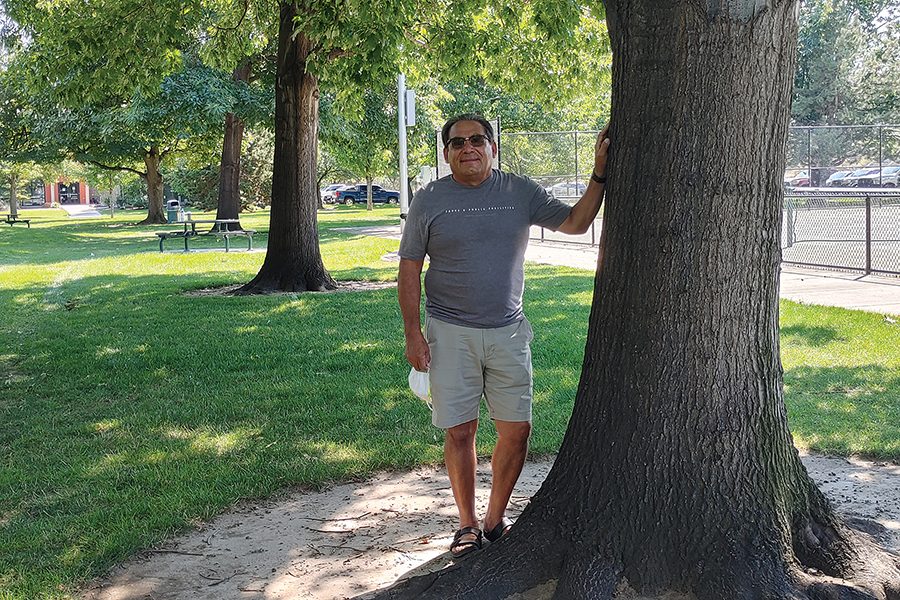
Home » Longtime arborist says goodbye to Richland and its 5,800 trees
Longtime arborist says goodbye to Richland and its 5,800 trees

September 14, 2020
It was a hot August afternoon and Ruben Rojas was three days away from retiring as Richland’s chief arborist — the man in charge of the 5,800 trees that dot city parks and properties.
It was fitting that he took a final interview at Howard Amon Park, social distancing at a picnic table not far from the Lee Boulevard turnaround. A silver maple with a trunk more than three feet across cast a wide shadow.
The maple is an impressive specimen occupying pride of place in the city’s premier park. It’s not his favorite species, but he pronounces the tree healthy.
It’s also a marker of Rojas’ legacy in Richland.
The towering maple survived a 1989 windstorm that toppled trees across the city. Plenty did not survive and the resulting mayhem led Rojas and his team to replant the city’s parks with more durable varieties than the ones available to the people who originally planted elms and black locusts that split and drop branches.
The storm battered Howard Amon and the shelterbelt and much of the city. A commercial roof landed on George Washington Way. A sailboat crashed into an intersection. Trees fell everywhere, he recalled.
Wind events are not tracked as well as other types of storms, but it appears a major one rolled through the Tri-Cities on May 18 that year. Winds topped 60 miles per hour at the Tri-Cities Airport, according to National Weather Service and Tri-City Herald reports.
Rojas, assigned the only city vehicle that could communicate both with dispatchers and multiple departments, spent the day routing cleanup crews to blocked streets.
Once emergency routes were cleared, they turned their attention to parks.
Howard Amon was an unwalkable jumble of fallen trees and limbs. The shelterbelt too.
“I had trees literally picked up by the roots and thrown around,” he said.
Someone had the idea to invite the public to cut up fallen trees for firewood. People showed up, but when they started cutting down live trees, the invitation was revoked.
When the debris was cleared, Rojas was left with the municipal equivalent of a blank canvas: A park in need of trees.
“That gave me an opportunity to be more selective about trees,” he said.
A Federal Emergency Management Association grant paid for replacements. Saplings arrived by the truckload. The city set up a makeshift nursery.
Today, those young oaks, red maples and other durable species tower alongside the silver maple. Rojas is also a devoted experimenter, eager to plant modern hybrids if they suit a location.
He’s less fond of the cottonwoods that were widely planted across Richland.
They grow fast but they die back fast too. Limbs fall — heavily — from great heights. Rojas, who turns 65 in October, said he’ll climb up to 80 feet in a tree. With cottonwoods, there’s still 20 to 30 feet overhead.
“You don’t want to put in cottonwoods,” he said.
Rojas, who has served on the state urban forestry council, helped launch the Mid-Columbia Community Forestry Council, which posts advice about what to trees work best in a desert at trees4you.org.
“The right tree for the right location” is the philosophy that guides what is planted and where both in parks and at city facilities.
Rojas lends his expertise to developments across the city. Richland’s new City Hall has specially selected varieties he said will grow and age well with the structure.
Howard Amon is Exhibit A for the benefits of taking a long view.
To ensure a mature canopy, the city routinely plants young trees near aging ones. He prefers larger saplings — three inches or more across — because they can stand up to the damaging curiosity of children. The city seldom loses a newly planted tree because it takes care to put them in the right spot, with the right water.
When their old friends must be removed, the young trees have matured enough to take on their place.
Rojas said the city tries to be transparent about tree maintenance. It posts notices when trees are set for removal.
The area near the tennis courts, south of Lee Boulevard, is a good example of how pairing new with old has paid off.
Four oaks quietly matured near two towering elms along the eastern fence. When the elms had to be removed, a mature line of trees was already in place and the elms were not missed.
The urban forestry program Rojas leads is a big part of Richland’s great network of parks, said Joe Schiessl, who leads the parks and recreation system.
“He’s created a legacy for future generations. It’s something he should be very proud of,” he said.
Rojas is mindful too that Richlanders love their trees and are quick to object to them being cut down.
Once, when the city hosted a tree care conference, several trees were marked with yellow ribbons as part of the program, triggering alarmed calls.
Rojas is no fan of removing trees. But he will not shy away from the job either, pointing out several spots where trees once stood.
“I don’t like taking down trees though,” he said.
He credits the diligent scrutiny and a commitment to tree health, which includes removing hazardous trees, for the overall health of Richland’s urban forest.
Rojas said he’s most proud that there have been no falling limb injuries during his tenure as chief arborist.
Rojas, one of two certified arborists with the city, inspects trees prior to major events such as the Art in the Park. He’s confident the attention to the city’s trees will continue when he’s gone. The city will name a new chief arborist, Schiessl said.
Rojas moved with his family to the Tri-Cities in 1963. He went through Pasco High School and took courses at Columbia Basin College and Washington State University to become a certified by the International Society of Arboriculture.
He joined the city in 1978 as a temporary maintenance worker. He soon landed a full-time job and held a series of positions in parks, then the landfill and then energy services before becoming the parks maintenance lead in 1989 — the year of the storm — and lead arborist in 1994.
“It’s been a good ride,” he said.
Local News
KEYWORDS september 2020





